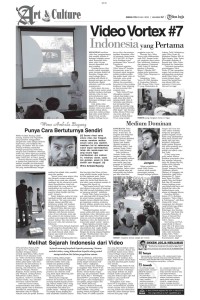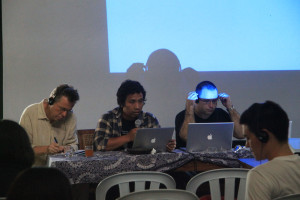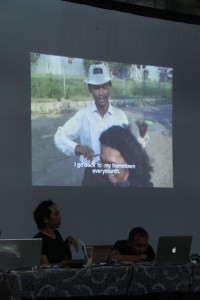Video Vortex 7 Yogyakarta | bios | timetable | conference program | workshops | practical info | credits / contact
SEMINAR DAY ONE: WEDNESDAY, 20 JULY 2011
Video in Indonesia: Histories, Aesthetics, Networks
Kedai Kebun Forum
Session 1: Video Art as/in Art History [raw video available here!]
Presenter: Ade Darmawan (ruangrupa) and Agung Hujatnikajennong (ITB). Moderator: David Teh (NUS)
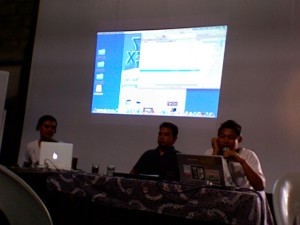
Ade Darmawan
In the history of Indonesian video art, the centres have not always been that influential. New initiatives emerged throughout the country. After the political changes in 1998, new initiatives moved towards an institutionalisation. These initiatives, on the form of small- to medium-scale institutions have had an important role in the historicisation of Indonesian video art. These institutions have contributed alternative narratives/histories of Indonesian video art. In Indonesia, the usage of video has strong connections with the video practices of a wider public.
Agung Hujatnikajennong
The question ‘Is there any history of video art in Indonesia?’ is itself a result of authoritarian power and its communication mechanisms during the New Order. History is always in a questionable position. This is encouraged by the lack of infrastructure and archives. From the perspective of technoculture, Agung sees two tendencies in video art production in Indonesia: the critical and the affirmative. The critical was by the 1990s generation such as Krisna Murti (Learning to Queue up to the Ants) and Heri Dono (Gamelan of Non-communication). The affirmative position refers to an article by Ronny Agustinus, who wrote that after 1998, video became popular due to the freedom of expression and access to technology. Local TV was mushrooming, while celluloid technology was expensive. From the OK.Video festival, we can read many styles and types of video production made by artists as well as amateurs. This new generation was closer to technology than the previous one.
Session 2: Video Aesthetics [raw video available here!]
Presenter: Aminuddin TH Siregar (ITB) and Thomas J. Berghuis (University of Sydney). Moderator: Andreas Treske (Yasar University)
Aminuddin proposed some questions on the ontology of video arts in an Indonesian context. Can we see this category in parallel with ‘video art’ in the West? Video art has become very popular in Indonesian contemporary art, and has now been approached by the market. This indicates that video art is no longer a marginal art. Like photography, video art is becoming mainstream, something it seems we never expected Initially, video incited debate and conversation, but in fact, it was adopted without significant conversations; which leaves us with some aesthetic problems. Indonesia sorely lacks productive conversations. The understanding of technique and theme, distribution and exhibition is uneven. Aminuddin is afraid that video has failed to become an art form in Indonesia. He observed that most videos contain only jokes, and are naïve, without evidence of much research.
This, he says, is because there isn’t an understanding of the concept of ‘art’, as there is in Western culture. Can the Western concept ‘art’ be assimilated with the Indonesian concept ‘seni’ (art)? In this context, what can validate video as an art form and how is this process going on? What’s a valid definition of video art in an Indonesia context?
Thomas J. Berghuis
In his presentation, Thomas tried to dig into the aesthetics enabled by video. First, video as an archive. Before understanding what video is, particularly in a comparative context between Asian and Western art, we need to go back to the archives. Video can be one archive model, and its development, its archiving process, can also be an “art”. Secondly, Thomas introduced the “Edge of Elsewhere” exhibition in Sydney, whose curatorial framework took in art and community, as well as communal production models. With reference to this project and some recent work of Chinese artist Wang Jianwei, Thomas explored how video’s characteristics make possible performative and artistic processes that are social.
Finally, he noted that video’s actors are capable of intervening in public space, of remediating and transforming reality into other media forms. The artist then is able to create new spaces, new dimensions that invite people to think differently.
SEMINAR DAY ONE Wrap-up Session
(led by KUNCI’s Nuriaini Juliastuti) [raw video here!]
SEMINAR DAY TWO: THURSDAY 21 JULY, 10.30am
Video in Indonesia: Histories, Aesthetics, Networks
Kedai Kebun Forum
Session 1: Alternative Histories of Video [raw video available here!]
Presenter: Hafiz (Forum Lenteng, ruangrupa), Andang Kelana (Forum Lenteng), Otty Widasari (akumassa) and Aryo Danusiri (Harvard University, ragam), Moderator: Antariksa (iCan)
The Forum Lenteng (FL) session was moderated by Antariksa, who introduced FL as the ‘avant-garde’ of alternative video in Indonesia. They gave two presentations: one from the ‘Videobase’ research project (presented by Hafiz) and another from the perspective of the more developmental Akumassa network (presented by Otty and Andang). Here is a summary of the presentations, followed by some remarks by Aryo Danusiri (respondent) and a wrap-up by David Teh.
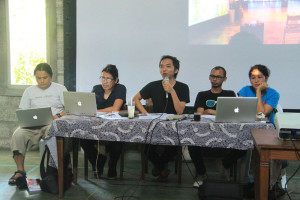 Hafiz, Andang Kelana, Otty Widasari
Hafiz, Andang Kelana, Otty Widasari
In 1928, Soekarno, Indonesia’s first president (1945-1965) forecasted the importance of television for uniting Indonesia: “ How I yearn, that someday in the future, when my fellow nationalist revolutionaries, quietly, with the help of the most modern facilities, will watch on television as the imperalists roll up their last mattress.” Soekarno had not watched television, which was still developing in the West. Rather, he was responding to an optimistic article about the future of television published in the daily Pewarta Soerabaia on 2 May, 1928 and entitled “Television, Satoe Pertjobaan antara London dan Parijs” (‘Television, an experiment between London and Paris’). Thirty-four years after his statement, Soekarno established a national television service, Televisi Republik Indonesia (TVRI) on 17 August 1962, to commemorate 17 years of Indonesian independence. Soekarno delivered a speech proclaiming that 1962 was a year of victory, as an era of progress and modernism, signified by the presence of television, was dawning.
Right after 1965, when Soekarno was replaced by Soeharto’s authoritarianism, TVRI practically converted into the regime’s propaganda apparatus. TVRI was being used as ‘untuk membina kebudayaan nasional’ (to develop national culture). The New Order government itself was careful not to let television and audiovisual technologies develop without control. These technologies were heavily regulated, including film and television. By 1975, 42 million or 32% of Indonesia’s total population could watch television. In 1976, Indonesia launched a Palapa satellite, becoming the first third world country to operate this technology. After the launch, the government established audiovisual production centers in each province, and soon TVRI was broadcasting nationally through its 6 studios and 26 transmitters.
Video was introduced in Indonesia in the 1980s and was limited to an elite class. Both beta and VHS players were used. Then the video camera itself became available and was limited to film/television professionals and a limited number of the upper class, as it was still very expensive. However, film professionals did not find any artistic appeal in video. It was seen simply as an apparatus that was easy to work with. Consequently, there was no experimentation done with this medium. Asrul Sani, a prominent film director, went as far as to say that video did not enable the creation of a new visual language. This situation is quite different from what happened in Europe, where video encouraged experimentation and the emergence of a new visual language. Nonetheless, video’s popularity was growing during the 1980s. The market was certainly the major driver, but there was more than that, as people wanted new visual experiences. They wanted to see new things, while the regime ensured that TVRI was the only channel for technological representation. This was proven by a phenomenon called village video. Video played a role as an alternative outlet to television. Therefore, unlike some other places, where video has developed in and with television, in Indonesia television was largely reserved for the government’s propaganda. The development of video technology was carried out through video rental businesses throughout the country.
Video technology was thus quickly absorbed and became an important part of a new visual experience, with a new ontology of viewing: it brought pictures that were supposed to have been censored by the regime, including those containing violence and sexuality/pornography. This was considered too threatening by the government. In 1981, the electronics industry was skyrocketing; the market grew by 20%; sales of televisions and cassette radios showed significant increases. Videocassette players and video games became more and more popular. And video theatre was replacing celluloid theatre. Not only did video rental mushroom, inter-city buses were also fitted out with video equipment to attract passengers.
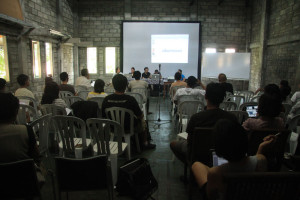 Video was everywhere and getting harder to control. At this point, the New Order government saw video as a subversive medium. It threatened to undermine the unity and existence of the Indonesian state. The government soon released regulations for video. In 1981, the National Film Board (with involvement of the powerful Politics and Security Office, intelligence agencies, etc) organized a seminar entitled “Video Technology Management for Development”. The seminar put much attention on the negative and moral impacts of ‘negative’ films (porn).Beside the moral threat, government paid attention to videos that allegedly contained communist tones. A case in point was a video called Collie (India); which portrayed the protest of the working class bearing communist flags. This also applied to the video “Long Live Mao Tse Tung!”, part of a video called “National Chinese Sports Week” found in Bandung, West Java. As a consequence, the government regulated the distribution of video and implemented strict censorship.
Video was everywhere and getting harder to control. At this point, the New Order government saw video as a subversive medium. It threatened to undermine the unity and existence of the Indonesian state. The government soon released regulations for video. In 1981, the National Film Board (with involvement of the powerful Politics and Security Office, intelligence agencies, etc) organized a seminar entitled “Video Technology Management for Development”. The seminar put much attention on the negative and moral impacts of ‘negative’ films (porn).Beside the moral threat, government paid attention to videos that allegedly contained communist tones. A case in point was a video called Collie (India); which portrayed the protest of the working class bearing communist flags. This also applied to the video “Long Live Mao Tse Tung!”, part of a video called “National Chinese Sports Week” found in Bandung, West Java. As a consequence, the government regulated the distribution of video and implemented strict censorship.
It wasn’t only ‘regular’ video that was being regulated; video games were among the things that, it was claimed, could undermine the interests of national development. In 1981, there was a video game exhibition in Glodok Plaza Building, Jakarta, entitled “ATARI EXPO”. This exhibition was an important step towards the introduction of video games in big cities such as Jakarta, Bandung, Yogyakarta, Semarang, Surabaya and Medan. As with ‘regular’ video, video games fell under the regime’s surveillance apparatus. After several incidents involving fights in video game centers, the government closed down these places in the name of moral concerns that video games were dangerous for kids. This particular period demonstrates that the adoption of video technology drew two contrasting reactions. For the people, video technology was seen as a symbol of freedom of expression and information, while government saw video as subversive technology with the potential to ruin the nation’s morality.
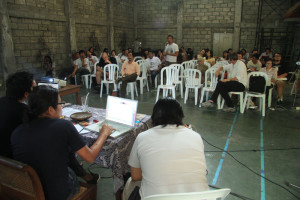
Aryo Danusiri
In Forum Lenteng’s research, “Videobase”, video is seen as a mediation apparatus and that’s interesting. However, in the study of technology, we should not forget the role of technology itself as a disciplinary apparatus. It’s important to keep in mind the processes of migration and translation. In this light, the role of technocrat and academician are pivotal.
Technology is not a neutral tool. It has always been shaped by and attached to various interests. “Videobase” research project sought to assess the tension that arises in the development of technology, between government/state and the people. However, the research should also look more carefully at the position of the market, of video’s place in a wider commodity circulation.
David Teh
The Videobase research was a vital contribution to the Video Vortex discussion, placing the medium on a concrete historical and economic background, indexed here by rich primary materials including news clippings, advertisements and items from archives both public and personal. Hafiz began by describing their project as research into the “history and spirit” of video in Indonesia, but pieces of its pre-history were pivotal. The story reached back to the 1920s premonitions of the country’s founding father, Soekarno, about audio-visual media. This touchstone from pre-independence underscores that the potential of televisual media was an ever-present component of the dream-machine that helped to found (and consolidate) the modern state. The idea of starting a TV station emerged in 1962 and by the early 70s, Indonesia had become just the third nation to use a satellite for broadcasting purposes. The charm and ‘magical aura’ of media technology is important background to the emerging electoral politics of the early New Order.
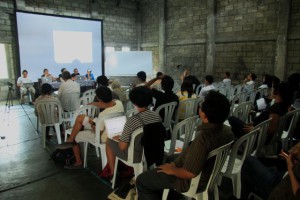 Much of FL’s narrative unfolded in the 1980s, when Suharto’s authoritarian regime was at its peak – crony capitalism yielding double-digit growth – implicitly grounding the medium’s development within a wider Southeast Asian economic and political history. An opposition quickly emerged between the people (as consumers of technology) and the state (as an increasingly technophobic authority). In 1981 a bureaucratic/military seminar was held to assess the likely social impact of video. Amongst its conclusions was the belief that video would have no real applications in art/cultural production. The potential for commercial entertainment, however, was self-evident. With reference to old magazine ads from Sony and other companies, a picture emerged of a technology that stood primarily for access to a new era of entertainment. In the early 80s, production was still beyond the reach of most consumers. Yet the medium expanded fast, with the growth of ‘home cinemas’, important sites for a communal encounter with the video image. Some viewers paid for this, some watched for free. The unregulated home cinema was a new public space that represented a threat to the state, as did stores like Video Tara (the first duplication and rental company in Jakarta) and the arrival of video game technology (from 1981). Both of these latter channels were subject to police/military raids in the early years. In the discussion that followed, Antariksa warned of the enduring nature of this technophobia – comparing it to, e.g., New Order campaigns against communism – and how it still conditioned the attitude to video: “technology is always held responsible by those giving voice to moral and ideological fears.”
Much of FL’s narrative unfolded in the 1980s, when Suharto’s authoritarian regime was at its peak – crony capitalism yielding double-digit growth – implicitly grounding the medium’s development within a wider Southeast Asian economic and political history. An opposition quickly emerged between the people (as consumers of technology) and the state (as an increasingly technophobic authority). In 1981 a bureaucratic/military seminar was held to assess the likely social impact of video. Amongst its conclusions was the belief that video would have no real applications in art/cultural production. The potential for commercial entertainment, however, was self-evident. With reference to old magazine ads from Sony and other companies, a picture emerged of a technology that stood primarily for access to a new era of entertainment. In the early 80s, production was still beyond the reach of most consumers. Yet the medium expanded fast, with the growth of ‘home cinemas’, important sites for a communal encounter with the video image. Some viewers paid for this, some watched for free. The unregulated home cinema was a new public space that represented a threat to the state, as did stores like Video Tara (the first duplication and rental company in Jakarta) and the arrival of video game technology (from 1981). Both of these latter channels were subject to police/military raids in the early years. In the discussion that followed, Antariksa warned of the enduring nature of this technophobia – comparing it to, e.g., New Order campaigns against communism – and how it still conditioned the attitude to video: “technology is always held responsible by those giving voice to moral and ideological fears.”
In the 80s, though, the state did respond with production, as well as regulation. Collaboration between Phillips and the Information Ministry saw mobile TV trucks and video buses sent beyond the big cities. Hafiz showed a still from one government production (1982) devoted to the modernization of farming methods, but noted that the farmers in the image were actors. For me, this is really a pivotal point in the Videobase research. At a glance, the image could very easily be the ancestor of a now very widespread genre, the village or community videos often facilitated by NGOs. This aesthetic lineage crosses the state/people line, and seriously compromises any investment that might be made in the veracity of this genre of video-images that occupies the ground of the non-official. This implicates not only journalistic or propagandistic images, but also perhaps some indie and even DIY genres. It raises for further investigation the relationship between the state as an aesthetic producer (rather than simply a regulator) and the explosion of NGO and community production more recently. It also underlines the importance (and potential) of experimental film aesthetics for evading the norms perpetuated on these channels. FL’s Massroom project was cited as an instance of resistance to the dominant ‘journalistic’ aesthetics of documentary.
Nevertheless, FL’s history suggests that video was a seed of a certain “democratization process” rooted not in politics proper but in the post-industrial sectors of media and entertainment. It was suggested in the discussion sessions that this research runs the risk of a too binary separation between ‘the state’ and ‘communities’ as opposed actors in the history. Aryo noted that other players should be included, such as the market and industry, each with their own narratives. Hafiz revised the distinction proposed by Agung in the first session (regarding ‘critical’ and ‘affirmative’ generations), adding a formal note: “the present generation should be characterized as ‘digital’, not ‘affirmative’.”
In their Akumassa project, FL seeds community media centers and builds media literacy through video workshops. Their presentation threw a contemporary, practical light on some of the issues raised by the first, and there was discussion (from Aryo and others) of the importance of challenging the aesthetic norms of the documentary moving image. How to avoid reproducing these norms? Otty noted that the priority for Akumassa was to assist communities in identifying and rendering their own stories and perspectives. The resulting productions often have the appearance of micro-histories or ‘found stories’ (Kracauer). One example, from West Sumatra, concerned a photographic portrait of a certain community leader that had become an icon for regional identity. This portrait had been disseminated far and wide, displayed particularly in Padang restaurants, though most of Java’s urban populations would not be able to identify its subject. Akumassa’s participants sought to tell this story in their own terms. In discussion, Andreas Treske picked up on this artifact as an anchor-point for the sorts of questions we might ask about video. This sort of photograph, he noted, marks in real life and space an important social and historical relationship, a shared identity and memory. When will we reach the point, he asked, that this image would be a moving image, a video?
Session 2: Video Online – impact, effect, affect [raw video available here!]
Some questions about the critical and democratic potential of networked/amateur video…
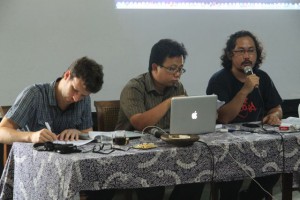
Ronny Agustinus
Ronny Agustinus commenced his presentation by noting the decline of porn film and video businesses, due to the emergence of amateur porn video on the Internet. In this context, he wished to emphasize the importance of amateur production in recent conversations about networked and online video. He said that amateur video had a lot of potential that was not shared by professionally made video: precisely because of their ‘innocence’, amateur videos look more authentic due to their unsophisticated fabrication and their ability to capture (sometimes inadvertently) fragments of a ‘real world’. Amateur video thus has the potential to improve the world by revealing an otherwise hidden reality. Ronny illustrated his argument with two exemplary websites: Beautiful Agony and Faces of Ecstasy.
The sheer volume and the participatory nature of amateur video on the web have been greeted with optimism. For some people this means progress and “democratization”. Institutional barriers have been falling: there are no longer cost constraints (neither high production costs nor the profit-and-loss calculations from box office records); there are no curatorial obstacles (either by festival juries, film and television censors, or critics, etc.); and there are no longer any formal technical or aesthetic standards. No matter how amateur, users have the right to record the videos they want to, and upload them to YouTube. In an Indonesian context, this phenomenon is not only a means of “democratization”, but also of “decentralization”: one no longer need struggle in Jakarta to become a national celebrity. It’s enough to make a video with a webcam or cellphone camera in one’s own village. Two sassy female students, Sinta and Jojo from Bandung and Briptu Norman, a member of the military (Brimob), from as far away as Gorontalo (Sulawesi) have proven the efficacy of social networking and launched themselves to instant fame. Or in other cases, like Ariel Peterpan’s sex tape, a video can ruin one’s entire career (and life).
However, not all amateur video, even that which contains scandalous material, will become popular in Indonesia’s virtual world. From his research, Ronny concludes that the popularity of a given online video depends on its coverage by mainstream media outlets. The power of mainstream media (based in Jakarta) as “the center of narrative” is thus not necessarily decentralized by the “democratic” network called the Internet. A second issue regarding online video was the question of whether the Internet provides space for diversity, or on the contrary, works toward homogenization. Referring to Andrew Keen (2007), Ronny noted that the Internet has not ensured the maintenance of democracy and diversity. This certainly presents a major challenge to amateur video’s defenders.
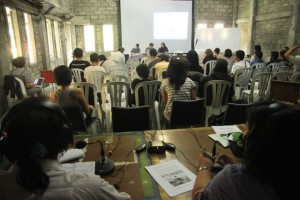 Another problematic issue with the Internet is corporate interests. A case in point is an amateur video suggesting the benefits of the Lapindo mudflow (an ecological disaster caused by a powerful Indonesian conglomerate, the Bakrie Group) for making bricks. The video was re-broadcasted on Bakrie-owned television, TVOne, in several news reports. In this case, amateur video was being used for corporate propaganda.
Another problematic issue with the Internet is corporate interests. A case in point is an amateur video suggesting the benefits of the Lapindo mudflow (an ecological disaster caused by a powerful Indonesian conglomerate, the Bakrie Group) for making bricks. The video was re-broadcasted on Bakrie-owned television, TVOne, in several news reports. In this case, amateur video was being used for corporate propaganda.
By way of conclusion, Ronny said he doubted the optimism around the potential and impacts of social media for ‘real’ political transformation (even in Indonesia, the second biggest Facebook community and sixth largest Twitter community in the world).
Andrew Lowenthal
Andrew Lowenthal also addressed the limitations of the Internet as a means of democratic change. He screened short excerpts from three amateur videos, which were popular for different reasons. The first shows the torture of a Papuan farmer by members of the Indonesian armed forces. The second is a video showing hundreds of villagers attacking followers of the (minority-Muslim) Ahmadiyah group. And the third was the sex tape of the celebrity, Ariel Peterpan, which landed its protagonist in prison, thanks to Indonesia’s anti-pornography law.
The three videos had some aesthetic similarities, notably, an aesthetic of authenticity. This is strange, as HD technology is becoming more popular. The first video was made with a cellular phone and was circulated quickly through human rights networks. The second video added an interesting perspective, since the perpetrators of violence were aware of their being recorded. These cases suggest that truth in video is less relevant than the context and the power relations determining where and how the video is being produced and received. Andrew proposed that we question how the cultural context in which a video is placed effects the ways it is received.
Several topics were covered during the discussion, including the (perhaps misleading) concern with a video’s volume of downloads, as well as the frameworks that might be used to think about online video. David Teh noted that in the case of these Indonesian videos, the national context found its relevance, but also its limits, since the political forces Andrew mentioned are part of wider, global movements. Antariksa added that if there is something unique about Indonesia, it is the modes of online video distribution; he also noted that the most popular online videos in the country are porn videos. **
SEMINAR DAY TWO Wrap-up Session
(led by KUNCI’s Ferdi Thajib) [raw video here!]
TUESDAY 19 JULY, 4pm
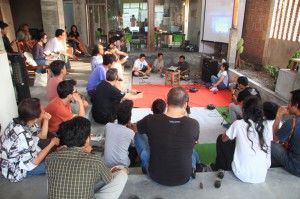 Video Vault – Special screening & Roundtable Discussion
Video Vault – Special screening & Roundtable Discussion
[raw video available here!]
with Jompet (Agustinus Kus Widananto), Farah Wardani and Pitra Hoetomo
at the Indonesian Visual Art Archive
(A brief summary)
The ‘Video Vault’ event aimed to review the development of Indonesian video art to date, and its anticipated future. Video works were drawn from the collection of the Indonesian Visual Art Archive (IVAA) and selected by cross-media artist, Jompet (Agustinus Kus Widananto). Jompet screened and provided live commentary to the selected videos, which ranged across various genres from video art to performance and documentation, etc.
Jompet started by noting that the videos reminded him of his early career as an artist. They might not reflect the history of Indonesian video art accurately, but they are important for artists to reconsider. In the 1990s, video could be seen as a lost child because it didn’t have a historical footing in Indonesia. The foster-father of Indonesian video art was television, a kinship that would later be denied. Due to the absence of archives, early video artists learnt from other artists of their era, international networks with foreign institutions having not yet developed. During the late 1990s, video art was heavily influenced by television. This was simultaneous with the early development of new media art.
To illustrate this, Jompet screened video from Hanhan. The video used footage from TV, reflecting the artist’s hostility toward that medium. From 1999 to 2001 was the craziest period in Indonesian video art’s development. Artists such as Marzuki, Venzha, Geber Modus Operandi, etc. worked and made significant videos. Geber Modus Operandi was one of the most influential groups in the late 1990s, incorporating digital technology into their performances. After this initiation period, by around 2002, many video artists and groups were emerging sporadically. The video scene was established. Selection occurred. Some survived, some fell apart.
Jompet then screened a second video, from Wimo Ambala Bayang (“Once Upon A Time in China”, 2005), a founder of MES56 and the popular Video Battle project in Jogja; and a third from Reza Afisina (2001), a Jakarta-based artist and member of ruangrupa since 2000. The latter collective has long been focused on the development of audiovisual media.
Reza noted that at that time, there were no groups or institutions working with video, so ruangrupa founded Ok.Video Festival (in 2003) which focused on the development of video. In 2001, their journal, “karbon”, published an edition dedicated to video art. Video proved popular and useful for the delivery of messages and for artistic practices that weren’t possible with conventional artistic media.
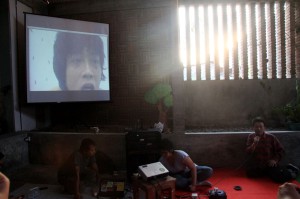 Talking about his own video, Reza addressed the ontology of the recording device, the camera functioning as an extension of his body. Apart from Ruangrupa, in Bandung there was the Bandung New Media Arts Festival and CommonRoom. Farah Wardani added that in the 2000s, there were groups such as biosampler, Garden of the Blind, and also advertising agencies, production houses, and those who made music videos. The role of Ruangrupa (and Ok.Video) is essential as they broadened the definition of video, not only in the visual art context, but also across other fields.
Talking about his own video, Reza addressed the ontology of the recording device, the camera functioning as an extension of his body. Apart from Ruangrupa, in Bandung there was the Bandung New Media Arts Festival and CommonRoom. Farah Wardani added that in the 2000s, there were groups such as biosampler, Garden of the Blind, and also advertising agencies, production houses, and those who made music videos. The role of Ruangrupa (and Ok.Video) is essential as they broadened the definition of video, not only in the visual art context, but also across other fields.
During the 2000s, Jompet and Farah Wardani observed that there were many videos that exploited the body in radical ways. David Teh saw this as the emergence of new kind of performative body. Some other important actors in Indonesian video art are Tintin Wulia and Forum Lenteng a collective which produces very challenging videos that record everyday life and its dramas. Forum Lenteng no longer celebrates video but uses it as a tool to communicate reality.
Jompet screened the video “Jalan Tak Ada Ujung” by Maulana Adel Pasha (Forum Lenteng, 2007). This work raised the relation between video and mobile phones. David Teh said that at that time, as critical internet communities were discussing ‘locative’ media, mobile phones (though not really mobile phone cameras) were appearing frequently in Indonesian video works.
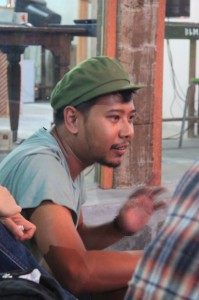 After 2006, there were video groups such as Video Battle, Kampung Halaman and others. After this period, IVAA gained access to more high quality video images. This period was quite critical for Indonesian video as there was a change in how video was being seen. After 2006, video gained a new position in the Indonesian social and art maps: it was increasingly used in social movements. Every artist or group found his/her own territory, network, style, theme, etc. Wimo Ambala Bayang recalled that after Jogja’s earthquake (2007), participatory video developed. Artists (particularly in Jogja) started to see video from a different perspective, not only as an art form, but as more than that.
After 2006, there were video groups such as Video Battle, Kampung Halaman and others. After this period, IVAA gained access to more high quality video images. This period was quite critical for Indonesian video as there was a change in how video was being seen. After 2006, video gained a new position in the Indonesian social and art maps: it was increasingly used in social movements. Every artist or group found his/her own territory, network, style, theme, etc. Wimo Ambala Bayang recalled that after Jogja’s earthquake (2007), participatory video developed. Artists (particularly in Jogja) started to see video from a different perspective, not only as an art form, but as more than that.
Jompet said that he picked videos from many artists who did not have backgrounds in film or video. They are mostly multi-media artists who do performance, installation, etc, as well as video. He gave some examples, such as videos from the prominent artists like Ugo Untoro and the painter, Agus Suwage, which stood at some distance from their non-video works.
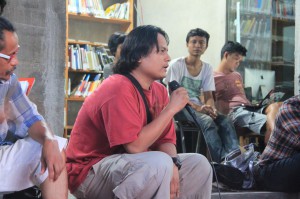 Aryo Danusiri shared his experience of making video. He made his first documentary in 1999. At that time, there was interaction between filmmakers and artists. Video was being used as a tool for journalism. From 2006, Forum Lenteng was producing videos that engaged the public. Many video- and film-making workshops were being organized. There were two aesthetic trends: those who interrogated the video medium specifically, and those who worked toward more developmentalist or utilitarian outcomes. In 2005, Danusiri worked on community video in Bali and at that time, the dominant video discourse is not to present ‘truth’, but to produce knowledge.
Aryo Danusiri shared his experience of making video. He made his first documentary in 1999. At that time, there was interaction between filmmakers and artists. Video was being used as a tool for journalism. From 2006, Forum Lenteng was producing videos that engaged the public. Many video- and film-making workshops were being organized. There were two aesthetic trends: those who interrogated the video medium specifically, and those who worked toward more developmentalist or utilitarian outcomes. In 2005, Danusiri worked on community video in Bali and at that time, the dominant video discourse is not to present ‘truth’, but to produce knowledge.
David Teh noted that authoritarian regimes and their monopoly on the mass audiovisual media (as propaganda apparatus) may have given the evidentiary image a bad name. Jompet added that there is a historical gap: the young generation did not know about Indonesian video artists that had worked before 1998. On the other hand, many artists who had worked in that period (under the authoritarian New Order regime) no longer worked after 1998. So our knowledge is limited to Krisna Murti, a pioneer of the Indonesian video art scene who is very comfortable with the ‘video artist’ label. Krisna Murti is very aware of his medium and is much influenced by Nam June Paik.
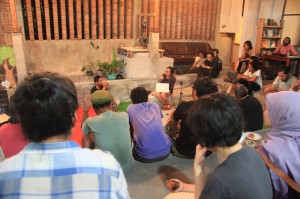 From 1998, there were important exhibitions, as video started to enter gallery spaces. The first was at Ardiyanto Gallery in 2007, and presented video works from artists such as Teguh Ostenrik, a lecturer at the Indonesian Arts Institute’s (ISI). The second was “Souvenirs of the Violence”, initiated by Ade Tanesia and held at Benteng Vredeburg, Yogyakarta. This exhibition included artists such as Sigit Pius and ISI students.
From 1998, there were important exhibitions, as video started to enter gallery spaces. The first was at Ardiyanto Gallery in 2007, and presented video works from artists such as Teguh Ostenrik, a lecturer at the Indonesian Arts Institute’s (ISI). The second was “Souvenirs of the Violence”, initiated by Ade Tanesia and held at Benteng Vredeburg, Yogyakarta. This exhibition included artists such as Sigit Pius and ISI students.
David Teh asked whether to see within Indonesian video practice a category of ‘video art’ was necessary or important? Farah Wardani answered that video art as defined in Western art discourse is visible in Indonesia, despite its lack of institutionalization. Thomas Berghuis concluded that the challenge lies in ‘history’ and historicization.
————–
MONDAY, 18 JULY 2011
Public Lecture: Video Spheres and Bubbles by Andreas Treske [raw video available here!]
Gedung Pascasarjana, Universitas Sanata Dharma
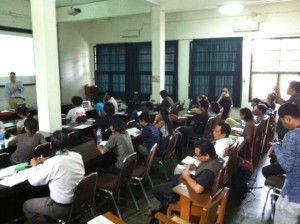
Andreas Treske delivering his lecture, ‘Video Spheres and Bubbles’ at the Graduate Building of Universitas Sanata Dharma. Tapping his previous essays for Video Vortex, Andreas extended his arguments and speculations on the directions screen culture is heading, with reference to its simultaneous shrinkages and expansions. He is currently developing a poetics of the sphere drawing on Sloterdijk’s epic theoretical trilogy. After the lecture the participants had lunch and a lively Q and A session, in the shadow of the university’s Soekarno banyan tree. Andreas was asked to elaborate on some of his philosophical positions, for instance, on whether the video-foam he described really amounts to an epochal supercession of an older regime of perspective and Cartesian rationality. The discussion also took in the ramifications of ‘video-spheres’ for Indonesian moving image cultures; and its possible points of contact with Javanese cosmology, metaphysics and urban planning.

MONDAY, 18 JULY 2011
Video Voyage: artists’ presentations + video art from The Philippines
@ Langgeng Art Foundation
Informal artists’ presentations by Allison Holt (US) and Akiq AW (MES56, Jogja), followed by a screening of new and recent video work from The Philippines curated and introduced by Clarissa Chikiamco (Manila).
[raw video available here (Allison/Akiq) and here (Clarissa)!]
[report by Veronika Kusumaryati]
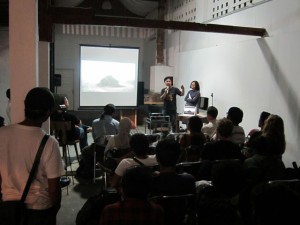 Akiq AW started the session by screening his works, “On Photographic Time and Motion”, a three-part series of videos that take up the traditions of photography and painting: portraiture, landscape and still life. The duration of each clip is 2 minutes and 10 seconds. Akiq AW is a photographer and member of contemporary photography group, MES 56, and runs a workshop programme for the collective. The work “On Photographic Time and Motion” has been exhibited in MES 56 Collective Exhibition at Biasa Art Space in Bali in 2010.
Akiq AW started the session by screening his works, “On Photographic Time and Motion”, a three-part series of videos that take up the traditions of photography and painting: portraiture, landscape and still life. The duration of each clip is 2 minutes and 10 seconds. Akiq AW is a photographer and member of contemporary photography group, MES 56, and runs a workshop programme for the collective. The work “On Photographic Time and Motion” has been exhibited in MES 56 Collective Exhibition at Biasa Art Space in Bali in 2010.
See Akiq AW’s On Photographic Time and Motion videos here: Landscape, Portrait, and Still Life.
Akiq AW used to work in photography. This series is his first foray into the video medium, a response to the curatorial frame of the Galeri Biasa exhibition, concerning recent developments in photographic techniques. He started from the question: After almost 200 years of development, is photography still understood like was in its early years? From his point of view, photography will continuously change.
He noted that the boundaries between photography and video are blurring. With the development of new technologies (digital camera, the digital photo frame), these boundaries are no longer relevant. On the production side, recent cameras can record both still and moving images, while on the presentation side, the digital photo frame can present photos with motion. From this point of departure, he wants to use photographic logic to understand the complexities of the recording process, how an artist captures reality with the recorder, and its presentation before the audience. In particular, this work focuses on the logic of photography, in the tension between moving and still images.
In the past, to capture movement, photographers used slow speeds or multiple exposures, producing images that appeared to be moving; but in fact movement with duration could not be presented due to the medium’s limitations. With the invention of digital cameras and photo frames, however, the technological barriers have disappeared; photography can now show a sequence of motion over a certain duration. In this work, the observer is always in a fixed position (as in photography), but the objects recorded show minor movements. This is photography that is videographic, and a video work that is photographic. “On Photographic Time and Motion” draws on traditions of photography and painting: portraiture, landscape and still life. Akiq AW noted that digital technologies and devices have changed our perceptions about photography and the moving image. The works examine the complexity of photo and video processes, and the putative boundaries between these mediums.
In the Q&A session, Akiq AW emphasized that artists should be aware of technological convergence. It’s important to talk about the context of media in which artists work, because boundaries between media are mainly determined by the technology. This agenda is set in the equipment industry rather than in the culture. He also observed that today’s audiences are extremely interconnected and that the type of viewer was therefore difficult for the artist to anticipate.
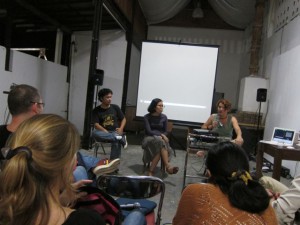
In 2009-10, Allison Leigh Holt lived and worked in Central Java as a J. William Fulbright Fellow through the U.S. Department of State, where the focus of her independent research was traditional Javanese concepts of multidimensional reality: the tools that traditional culture has developed to navigate it and the logic that underlies it. Through her own experience and the combined lenses of cognitive science, philosophy, science fiction, and theoretical physics, she explored Javanese methods of comprehension that extend beyond the world’s temporal and spatial limits, and the ancient system within which they function. In an open dialog format, Holt presented her ongoing research, consisting of video-sculpture and diagrams created in collaboration with members of House Of Natural Fiber, as well as video performances.
Holt noted that in traditional Javanese thinking reality is multidimensional – beyond our three dimensions lie parallel dimensions, expanding across time and space. In Javanese culture, there is a heightened attention to energy, not seen so much in the West. So her research was to explore the ways Javanese culture understands these dimensions, the ways its techniques are similar to her own way of thinking and working. With her background in sculpture, she is interested in using multidimensionality itself as a medium, for instance, by working in between film/video and performance.
She worked with a dhalang (puppeteer) and a dukun (shaman). She focused on the ruwatan (cleansing ritual) and explored the movement and behaviour of energy in this process. She made simple diagrams that she now uses as blueprints for her recent video and video-sculptural works. While in Yogyakarta, she also worked with House of Natural Fiber and an architect, Eko Prawoto. She showed 3 video works consisting of a diagram from her research in Java, an interactive video and a video performance that she recently presented at SF MoMa – links here and here. She noted that her experience in Java had stimulated her current video work. The idea of multiple realities is central to this development, informed by theoretical physics (the potential shapes of our universe) and her own spiritual experience. Javanese culture has a formal practice and concept of how energy is shaped. In the secular West, not as much is shared with the world we live in. In Indonesia, even if the prevailing culture is no longer the ‘traditional’ one that she researched, it’s not important because traditional ideas are still used as the basis of how people live. There is structure, a concept of how the universe exists and how we interact with its energies.
She showed 3 video works consisting of a diagram from her research in Java, an interactive video and a video performance that she recently presented at SF MoMa – links here and here. She noted that her experience in Java had stimulated her current video work. The idea of multiple realities is central to this development, informed by theoretical physics (the potential shapes of our universe) and her own spiritual experience. Javanese culture has a formal practice and concept of how energy is shaped. In the secular West, not as much is shared with the world we live in. In Indonesia, even if the prevailing culture is no longer the ‘traditional’ one that she researched, it’s not important because traditional ideas are still used as the basis of how people live. There is structure, a concept of how the universe exists and how we interact with its energies.
By presenting the diagrams and works, she hopes that the audience will have meditative experiences and be open to ideas beyond what they perceive in daily life. The audience should experience the three physical dimensions but also other energy, other dimensions. It’s her ultimate goal to give an audience a multidimensional experience. What kind of audience does she expect? The people on the street, she says. She always fights against the museum space as a segregated space, especially for media art that demands darkness. Hence, it’s a big challenge to communicate with ordinary people on the street.
 The Philippines Video Presentation with Clarissa Chikiamco
The Philippines Video Presentation with Clarissa Chikiamco
Clarissa Chikiamco presented her reflections working in the video art scene in the Philippines. Clarissa started working as curator of the End Frame Video Art Project which, when had begun in 2006 with an open call for submissions and selection by committee. But for the third and most recent iteration, Present, Clarissa changed the format to a series of solo exhibitions of Philippine contemporary artists. The reason behind this decision was that she wanted to format the festival so the audience could engage more deeply. Since 2006, the project had been organized in the common areas of a shopping mall, and in alternative art spaces in Manila. Most of video works in the exhibitions use experimental and playful strategies, rather than a more artistic/cinematic approach.
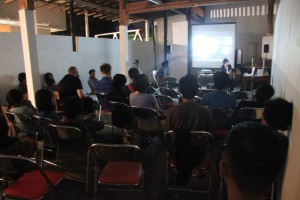 Regarding her curatorial approach, Clarissa noted that the project aims to raise awareness and a deeper comprehension of video art practice in the Philippines, rather than subjugate the works to a given concept. The Philippines has an unwritten video history. How, she asked, have contemporary Philippines artists been using video? She conceived solo exhibitions of seven artists that have consistently used video. She conducted research into their portfolios, to situate their work within a wider field of video practice in the Philippines. This became the springboard for her video research: she began with current practitioners, widening through their networks, then investigating video practices of the past.
Regarding her curatorial approach, Clarissa noted that the project aims to raise awareness and a deeper comprehension of video art practice in the Philippines, rather than subjugate the works to a given concept. The Philippines has an unwritten video history. How, she asked, have contemporary Philippines artists been using video? She conceived solo exhibitions of seven artists that have consistently used video. She conducted research into their portfolios, to situate their work within a wider field of video practice in the Philippines. This became the springboard for her video research: she began with current practitioners, widening through their networks, then investigating video practices of the past.
In her research, Clarissa has found that the artists’ practice mirrors her own. She has been struck by their self-reflexive thinking. For artist and curator alike, she said, it was important to develop an area of specialization, but also to avoid being narrowed by it. Philippines artists use video with a variety of strategies: performative, documentary, political and conceptual approaches, or engagement with the idea of the moving image itself. Some are exclusively video artists, some are not. They are not necessarily inspired by, or aware of, video art from other places. This suggests that she might get away from the issues of ‘medium specificity’ and the ‘post-medium condition’; it also returns her to the question of curatorial identity – how flexible is curatorial identity compared to artistic identity? Clarissa concluded by underscoring the curator’s double-role as a researcher, and the need for a video archive in the region.
FRIDAY, 22 JULY 2011
Workshop with Andreas Treske (TR/DE): non-linear storytelling
Hosted by FFD and Video Vortex [raw video available here!]
@ Indonesia Visual Art Archive
[coverage in The Jakarta Post here]
————
Coverage of Video Vortex #7 in Tribun Jogja (Kompas group) newspaper
